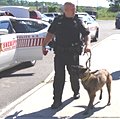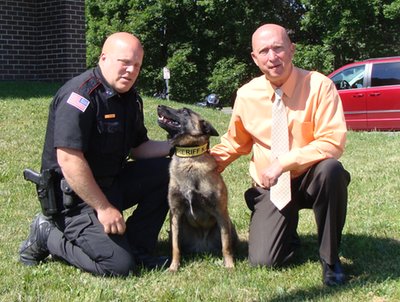- By Dan Veaner
- Around Town
 Print
Print  When Tompkins County's only K-9 law enforcement dog, Major, passed away his trainer, Deputy Shane Spencer approached Sheriff Peter Meskill, and then Sheriff Ken Lansing about getting a new dog. With County's budget crisis Lansing couldn't ask the County for funding. But Spencer had an idea for a donation program. They got the dog in April to make it in time to enroll in a training program. Thanks to very generous donations the Department paid for him two weeks ago.
When Tompkins County's only K-9 law enforcement dog, Major, passed away his trainer, Deputy Shane Spencer approached Sheriff Peter Meskill, and then Sheriff Ken Lansing about getting a new dog. With County's budget crisis Lansing couldn't ask the County for funding. But Spencer had an idea for a donation program. They got the dog in April to make it in time to enroll in a training program. Thanks to very generous donations the Department paid for him two weeks ago."We are limited as to the things we can do that way being a sheriff's department," Lansing says. This is one we were able to do legally. We had to move fast. We had some money in a donation fund, and we had to get the dog as quick as we could. Even though that money was there I didn't want to use it unless I had to. If we had to I would have taken it out of my own pocket."
He didn't have to. Spencer learned the Village of Horseheads, the Yates County Sheriff's Office, and Schuyler's County Sheriff's Office all have contribution programs for their K-9 units. With Lansing's approval he sent letters asking for donations from local organizations around the county. Cayuga Radio Group was one of those, and they responded with an offer to raise money on the radio. A dog costs $6500. The donation appeal raised about double that figure. Cayuga Radio Group alone raised $12,026 in a 12 hour period.
 (Left to right) Deputy Shane Spencer, Rock, Sheriff Ken Lansing
(Left to right) Deputy Shane Spencer, Rock, Sheriff Ken LansingThe result is a happy, healthy Belgian Malinois puppy named Rock who is well into his Patrol School training. Spencer says Malinois dogs are popular in the South because they have shorter hair. They are becoming more popular in the north as well. Being smaller than German Shepherds has the advantage that they fit into smaller spaces when sniffing out drugs, and Spencer says they are more driven and typically live longer. Rock goes to to Yates County for a ten hour training day each week. The rest of the time he lives with Spencer, who works with him on his training on his own time. Rock also patrols with his trainer, who has all the same duties as other deputies.
"Shane has what we call a 'Class A' car, which has two people riding together," Lansing says. "He always has the luxury of having a partner, and it makes a lot of difference. He takes all the calls. He's not just waiting for a K-9 call."
But when one comes he has to be ready. K-9 dogs are used for a variety of tasks, tracking criminal suspects, lost children and hikers, and people with Alzheimer's. School and jail searches are a big part of the dog's duties, as are demonstrations at schools and organizations around Tompkins County.
The Tompkins County K-9 program was started in 2000. Rock is the third dog Spencer has worked with since then. Bojar, the first dog, passed away when he was eight years old. He was replaced by a Belgian Malinois named Major. Major was only four when he died from a rare kind of cancer last March. Until 2006 there were five K-9 dogs in the County with one at the Sheriff's Department, three at the Ithaca Police Department, and one at the local State Police baracks. Since then only the Sheriff's Department has had a dog. Spencer says that during those six years calls for K-9 law enforcement and demonstrations have gone up by about 33%.
The K-9 program is actually a bargain for the Sheriff's Department. Purchasing the dog cost $6,500, but there is no salary or retirement benefits. Establishing a K-9 program requires some up-front expenses such as a specially equipped patrol vehicle and a kennel for the officer's house. But those are one-time or infrequent expenses. Then there are ongoing expenses like food, veterinarian bills, and so on. Purina has donated food for the Tompkins County program for the past 12 years, which amounts to about $600 per year. Lansing says that some veterinarians have expressed an interest in donating their services. That makes the donated money go farther.
"Purina has donated food for the Tompkins County program for the past 12 years," Spencer says. "If you figure about $50 per bag every month, that's $600 per year. Over the years that's quite a bit of money that we've saved. Currently we're in a patrol school, so we're not doing the narcotics part yet. (Rock is training for ) building searches. A burglar breaks into the DeWitt school in the middle of the night. An officer gets there and finds there was forced entry. Instead of risking the life of the officer, we send the dog in. The dog is equipped with a bullet-proof, stab-resistant vest that was donated by the FInger Lakes Kennel Club."
Spencer says it's worth it if the dog saves the life of one officer. Or if the dog can catch someone that law enforcement officers can't catch up to. Years ago Spencer and Bojar were called to ascene where a felony burglary suspect was running away from officers through the woods.
"He was a 17 year old kid," Spencer recalls. "He wouldn't stop so we sent in the dog. He ran like a deer. You have 35 year old guys trying to catch him and he just kept running. Once he saw Bojar coming he saw the dog and his eyeballs looked like a deer in the headlights. He just gave up."
 Rock is trained to grab a perpetrator's arm and hold on for dear life. In a demonstration (see video below) a deputy plays the role of the perpetrator wearing a red protective sleeve.
Rock is trained to grab a perpetrator's arm and hold on for dear life. In a demonstration (see video below) a deputy plays the role of the perpetrator wearing a red protective sleeve.Spencer says that the dog has to be carefully trained not only to capture felons and sniff out drugs, but also to be gentle around children, because a large part of Rock's duties will include performing demonstrations for kids.
Anyone with kids in high school know that police dogs periodically seach local schools for drugs, often finding them. In these cases neighboring county and municipal K-9 officers and dogs cooperate to make the search more efficient. Currently Rock is part of a group of nine or ten dogs who work together in these searches.
Tnly person at the school who knows about a K-9 search ahead of time is the principal. The dogs arrive at 10 o'clock and the principal announces the school is locked down. All the dogs come in at once, checking different parts of the school. If one dog alerts his trainer to a locker, another dog is brought there to run the same bank of lockers. If both dogs alert their trainers to the same locker, school officials handle the actual search after the dogs leave. Typically the school handles students with drugs in their lockers, especially if the locker contained marijuana. If heroin or cocaine is found the police are more likely to be involved.
Spencer says that 99% of the time when two dogs alert on the same locker it either contains drugs or belongs to someone school officials have already been watching for drug abuse. He says that the school searches really send a message that kids shouldn't bring drugs to school. Demonstrations at the schools and DARE meetings also send that message.
"He's a tiny little guy, but he's going to be very good for this department once he's fully trained," Spencer says.
That will take some time. It takes 380 hours of training to complete Patrol School, which only meets once a week. Spencer works with Rock on his own time to keep him current with his training. After completing the course an examiner comes from Buffalo or Syracuse to test and certify the dog. Spencer says Rock will be trained for patrolling y the end of August, and then will start a 180 hour narcotics training program. New York state requires 16 hours a month after the initial training, and the dog has to be re-certified every three years.
"That's the commitment," Spencer says. "When Sheriff Meskill was here we talked about putting another dog on. I had the only dog, and we were traveling. What if I go on vacation or I get sick? It would be nice to have another dog, and to have more coverage on the road."
Lansing would also like to add another dog, but in the current budget environment that may not be possible despite the overwhelming success of the donation program. But he is clear that every penny donated goes to the K-9 program, and that program only. And he says the measure of the program's success is not only catching felons and finding drugs, but also deterrence the demonstrations and school searches bring. He says the public outpouring of support to fund the new dog is another important measure.
"To see the outpouring of this community and the support they gave us... it showed that they feel it is important," Lansing says. "That is huge. A program like this is not unlike a DARE program and people say 'look at the money you're spending'. Where do we start putting value on it? If that dog goes out and finds a lost child today that's worth everything he's put into it. The measurement for me is knowing what the dog will do should we have to use him, and just going to the schools for demonstrations -- the joy that it brings to the community. Knowing that we can use that dog and knowing he can protect another officer is worth every moment we put into the program."
That kind of success brings a lot of satisfaction to Spencer.
"When I get done with a demo and see the kids smiling, that's really a good feeling," he says. "Or the burglary call -- they were chasing that guy all morning. When I got there I went up in the woods by myself because everyone else had given up. When I caught that guy I felt good, because all the time and effort that goes into the training paid off."
v7i26



